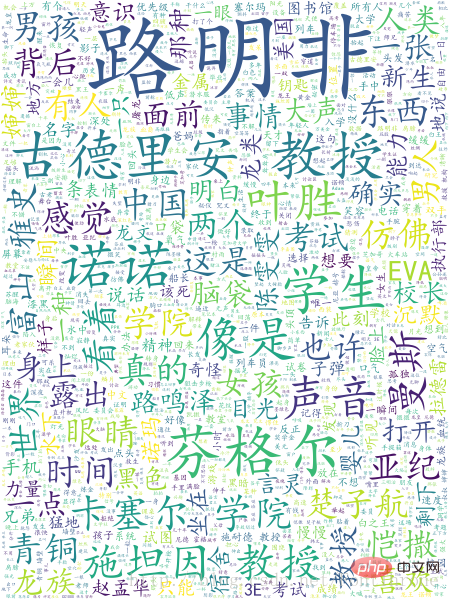
Le nuage de mots est devenu un sujet brûlant aujourd'hui. Comment générer un nuage de mots ? Cet article utilise Python pour générer un nuage de mots chinois comme exemple afin d'expliquer comment créer vous-même un nuage de mots.

Deux bibliothèques Python nécessaires à Python pour générer des nuages de mots chinois :
jieba : segmentation de mots chinois Outil de segmentation de mots
wordcloud : Outil de génération de nuages de mots sous Python
Introduction à la composition du code
La partie code provient des blogs d'autres personnes, mais en raison aux bugs Ou pour des raisons d'efficacité opérationnelle, j'ai apporté des modifications majeures au code
La première partie du code consiste à définir la plupart des paramètres nécessaires à l'exécution du code. Vous pouvez facilement utiliser le code directement sans. faire trop de modifications.
La deuxième partie concerne certains paramètres de jieba. Bien sûr, vous pouvez également utiliser le paramètre isCN pour annuler la segmentation des mots chinois
La troisième partie concerne les paramètres de wordcloud, y compris l'affichage et l'enregistrement des images
Recommandations associées : "Tutoriel vidéo Python"
##Use the code by comment ##
关于该程序的使用,你可以直接读注释在数分钟内学会如何使用它
# - * - coding: utf - 8 -*-
from os import path
from scipy.misc import imread
import matplotlib.pyplot as plt
import jieba
# jieba.load_userdict("txt\userdict.txt")
# 添加用户词库为主词典,原词典变为非主词典
from wordcloud import WordCloud, ImageColorGenerator
# 获取当前文件路径
# __file__ 为当前文件, 在ide中运行此行会报错,可改为
# d = path.dirname('.')
d = path.dirname(__file__)
stopwords = {}
isCN = 1 #默认启用中文分词
back_coloring_path = "img/lz1.jpg" # 设置背景图片路径
text_path = 'txt/lz.txt' #设置要分析的文本路径
font_path = 'D:\Fonts\simkai.ttf' # 为matplotlib设置中文字体路径没
stopwords_path = 'stopwords\stopwords1893.txt' # 停用词词表
imgname1 = "WordCloudDefautColors.png" # 保存的图片名字1(只按照背景图片形状)
imgname2 = "WordCloudColorsByImg.png"# 保存的图片名字2(颜色按照背景图片颜色布局生成)
my_words_list = ['路明非'] # 在结巴的词库中添加新词
back_coloring = imread(path.join(d, back_coloring_path))# 设置背景图片
# 设置词云属性
wc = WordCloud(font_path=font_path, # 设置字体
background_color="white", # 背景颜色
max_words=2000, # 词云显示的最大词数
mask=back_coloring, # 设置背景图片
max_font_size=100, # 字体最大值
random_state=42,
width=1000, height=860, margin=2,# 设置图片默认的大小,但是如果使用背景图片的话,那么保存的图片大小将会按照其大小保存,margin为词语边缘距离
)
# 添加自己的词库分词
def add_word(list):
for items in list:
jieba.add_word(items)
add_word(my_words_list)
text = open(path.join(d, text_path)).read()
def jiebaclearText(text):
mywordlist = []
seg_list = jieba.cut(text, cut_all=False)
liststr="/ ".join(seg_list)
f_stop = open(stopwords_path)
try:
f_stop_text = f_stop.read( )
f_stop_text=unicode(f_stop_text,'utf-8')
finally:
f_stop.close( )
f_stop_seg_list=f_stop_text.split('\n')
for myword in liststr.split('/'):
if not(myword.strip() in f_stop_seg_list) and len(myword.strip())>1:
mywordlist.append(myword)
return ''.join(mywordlist)
if isCN:
text = jiebaclearText(text)
# 生成词云, 可以用generate输入全部文本(wordcloud对中文分词支持不好,建议启用中文分词),也可以我们计算好词频后使用generate_from_frequencies函数
wc.generate(text)
# wc.generate_from_frequencies(txt_freq)
# txt_freq例子为[('词a', 100),('词b', 90),('词c', 80)]
# 从背景图片生成颜色值
image_colors = ImageColorGenerator(back_coloring)
plt.figure()
# 以下代码显示图片
plt.imshow(wc)
plt.axis("off")
plt.show()
# 绘制词云
# 保存图片
wc.to_file(path.join(d, imgname1))
image_colors = ImageColorGenerator(back_coloring)
plt.imshow(wc.recolor(color_func=image_colors))
plt.axis("off")
# 绘制背景图片为颜色的图片
plt.figure()
plt.imshow(back_coloring, cmap=plt.cm.gray)
plt.axis("off")
plt.show()
# 保存图片
wc.to_file(path.join(d, imgname2))


Résumé
Si vous souhaitez utiliser ce code pour générer un nuage de mots anglais, vous devez alors définir le paramètre isCN sur 0 et fournir un mot anglais liste de mots vides.
Ce qui précède est le contenu détaillé de. pour plus d'informations, suivez d'autres articles connexes sur le site Web de PHP en chinois!